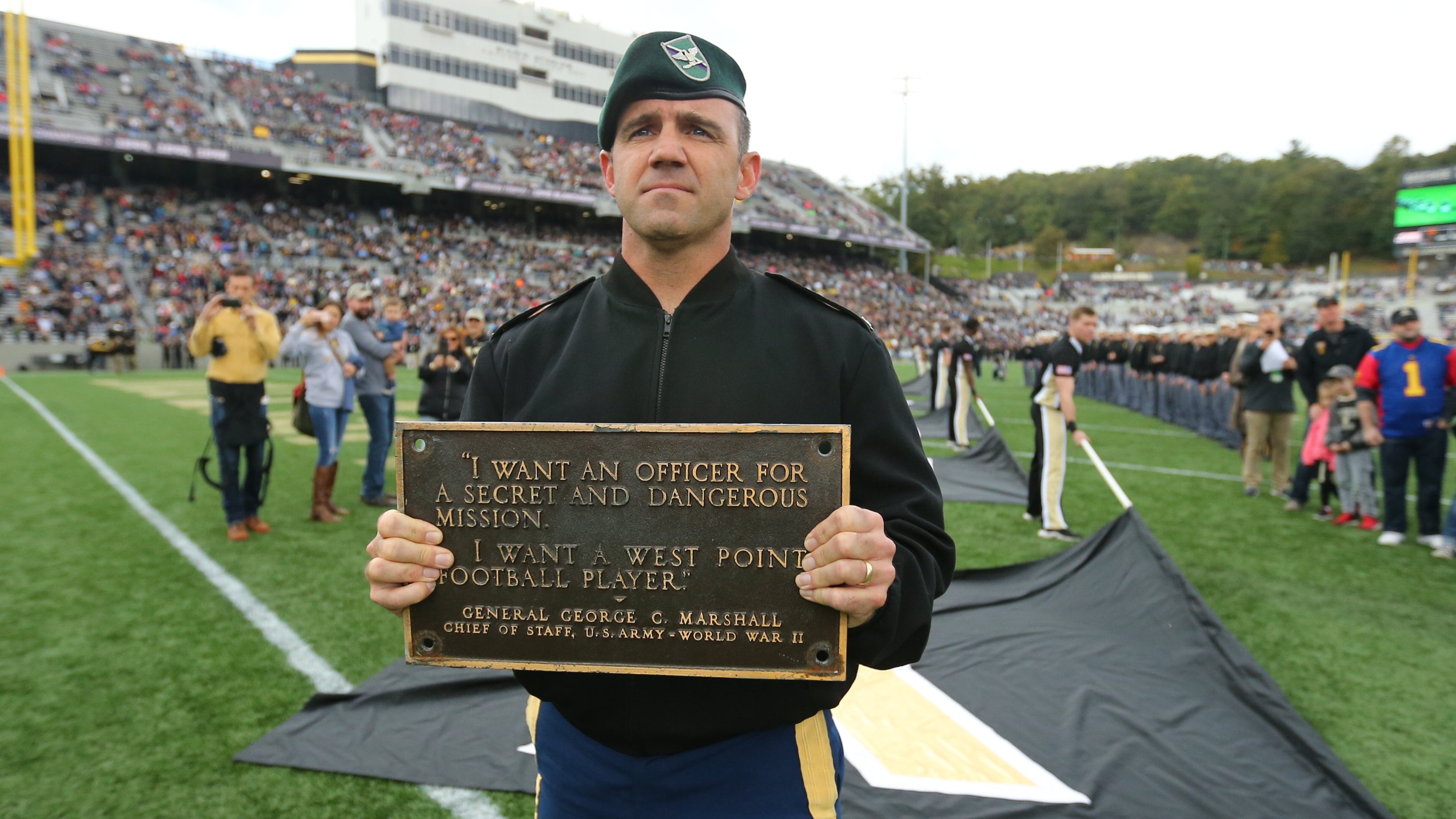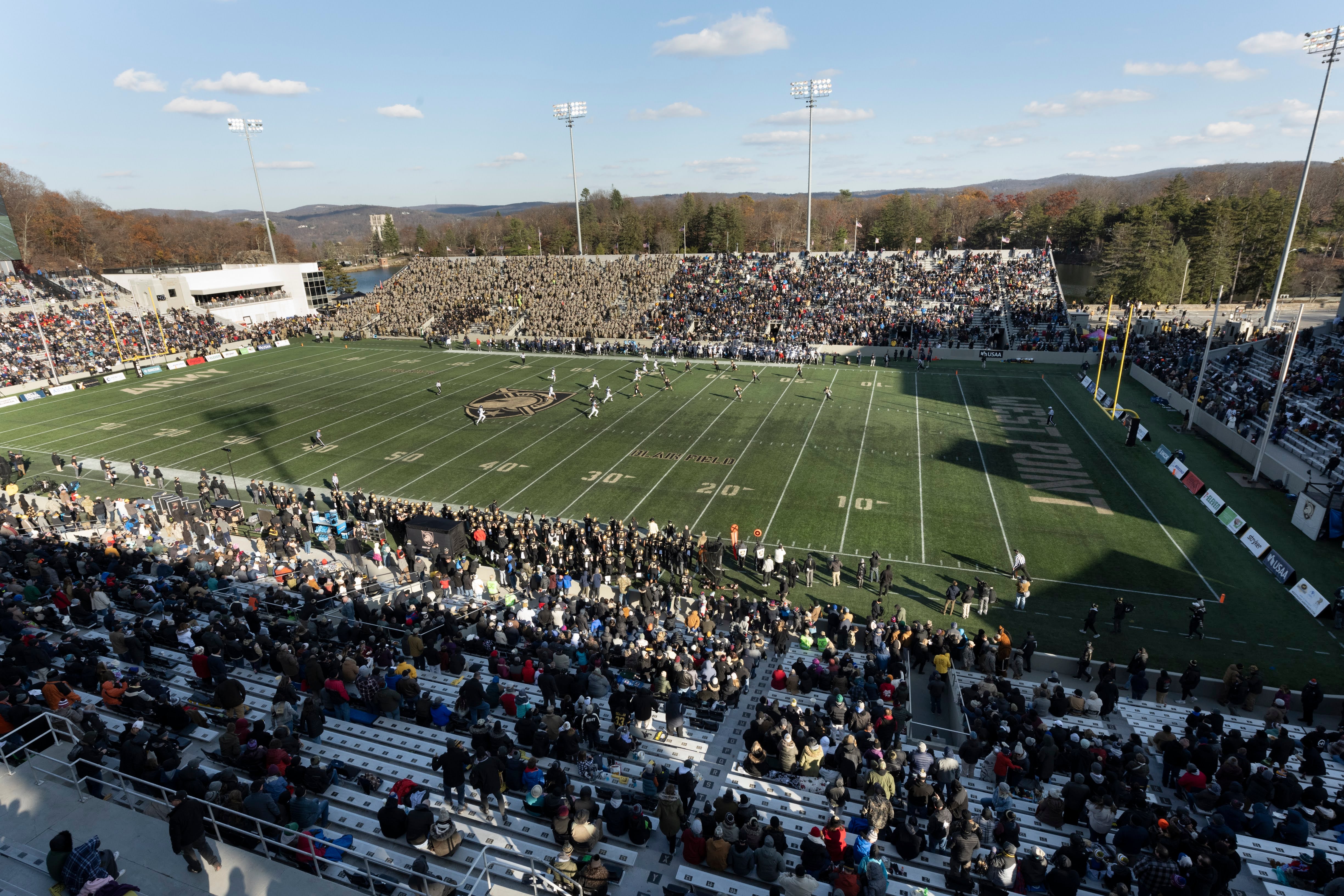It’s one of the most hallowed traditions in college sports.
When they take the field for games, whether at home in Michie Stadium, on the road, or at a neutral site like the one set for Saturday’s 123rd playing of the Army-Navy game, West Point’s football players all touch a bronze plaque bearing a purported quote from Gen. George Marshall, the service’s chief of staff during World War II.
Held each week by a different officer with ties to the program, it reads, “I want an officer for a secret and dangerous mission. I want a West Point Football player!”
RELATED

While it’s not certain that Marshall ever uttered those words, other key Army leaders (such as Gen. Ray Odierno, who served as chief of staff from 2011 to 2015) previously reflected on the value of their West Point football days.
This inspired Army Times to test a related hypothesis: are West Point football players more likely to become general officers than their peers, and are they more likely to ascend into key three- and four-star roles?
In short, yes. To reach this conclusion, we analyzed data from the West Point Association of Graduates, the Army’s General Officer Management Office, the Defense Manpower Data Center, official Army histories and legislative archives. We also researched biographies of former chiefs of staff.
Army Times found that West Point football players who graduated between 1975 and 1998 were more likely to attain every leadership category we studied:
- West Point football players have been 3.41 times more likely to make it to at least brigadier general than the entire population of officers (165,909) who didn’t play football there.
- The disparity between the two groups is even greater for senior general roles, with West Point football players being 6.02 times more likely to earn a third or fourth star.
- The football players even outpace their West Point peers, attaining general officer rank at a 1.4 times greater rate than members of the Long Gray Line who aren’t gridiron vets.
- For senior roles, football alumni have reached the three- and four-star ranks at a 1.89 times higher rate than West Point grads who weren’t on the team.
The study’s methodology, and its potential shortcomings, are discussed at length in a companion story. Army Times reviewed existing literature on general officer promotions and was unable to locate any publications that have previously documented the link between West Point football graduates and the general officer ranks.
But correlation doesn’t necessarily indicate causation.
Why would more football players become generals?
Army Times discussed the analysis with two experts on the service’s general officer ranks: Col. Todd Woodruff, a West Point sociologist and director of the West Point Leadership Center, and Katherine Kuzminski, who oversees the Center for a New American Security think tank’s Military, Veterans, and Society Program. Both have studied what factors predict career success for Army officers.
Woodruff told Army Times that its findings were “not surprising” but confirmed their novelty. He argued that the link isn’t due to any “nefarious thing…like nepotism,” but rather because of “a combination of the special qualities and characteristics that are built” through a football player’s experience at the academy.
In Woodruff’s eyes, most officers who are competitive for promotion to brigadier general have similar capabilities and operational backgrounds — successful battalion and brigade command time, successful stints in professional education, exceptional performance evaluations and more.
Both he and Kuzminski pointed to an “academy advantage” that researchers have documented. According to a 2019 RAND study co-authored by Kuzminski, West Point grads — regardless of football — “surge in their share of officer positions” when entering the general officer ranks. And by the time they reach three- and four-star roles, members of the Long Gray Line “make up the vast majority of positions.”
Physical fitness, or “physicality” also matters within the Army’s culture, the experts said. Young officers are evaluated on their fitness and their “presence” while leading, and top-performing football players are anecdotally more likely to be tall and in good physical shape.
“Culture matters,” said Woodruff. “And in the case of the U.S. Army, physicality matters.”
Woodruff also emphasized that officers in combat arms branches such as infantry or armor (which he said football players are more likely to select) are more likely to become generals than their peers. Kuzminski’s 2019 study highlighted that phenomenon, demonstrating that combat arms officers begin with a plurality of brigadier generals and increase in their overrepresentation with seniority. Nearly 90% of four-star generals they studied were from the infantry or armor branch.
West Point officers already benefit from a significant networking advantage once they enter the force, too. And for football players, that effect might be heightened.
Woodruff highlighted that football players have “an even closer group that…[they’ve] struggled and bonded with,” adding that “those closer ties in a broader network do matter.”
The CNAS expert agreed. “If you think that the network of West Pointers is tight, then the network of former football players is even tighter,” she said. “And the fact that there’s historically been more general officers who played football at West Point means that football players who come up behind them are part of that network.”
Gender also plays an undeniable role in the data — for the majority of these officers’ careers, women have been shut out from the combat arms branches and the promotion advantage it provides. And all West Point football players are men.
Kuzminski argued that football players experience a “compounding of that network effect and the selection effect” that favors the traits they possess as physically-imposing, male academy graduates who skew towards combat arms careers.
“There’s already so many gates to get to” the general officer ranks, but if you’re a West Point football player, she explained, “There are advantages at every gate you pass.”
Woodruff and Kuzminski also suggested further research could determine whether the football phenomenon is unique, or if other athletes with similar traits also become generals at similarly elevated rates. Both agree that any of the factors described would need to be controlled in future studies in order to isolate sports participation as the only variable.
The CNAS official said she’s curious whether athletes on other very physical NCAA sports teams such as hockey or basketball (men’s and women’s) are also overrepresented among generals.
But Woodruff thinks there might be merit to the idea that football is special.
“They develop grit, commitment, [and] conscientiousness. They understand the practice of building teams — and cohesive winning teams,” the colonel explained. “And then when you combine with that the network effect, and maybe some more intensive mentoring that they get…those things come together to give them some advantages.”
His conclusion was clear.
“This is good, and it’s largely something that they’ve earned.”
Notable West Point football alums who became generals
- Gen. (and future president) Dwight Eisenhower was a running back on the West Point football team until he injured his knee.
- Gen. Omar Bradley, who was the service’s chief of staff from 1948 to 1949, was Eisenhower’s teammate at the academy. He also was a star baseball player there.
- Gen. Matthew Ridgway, the 82nd Airborne Division’s original commanding general and later chief of staff from 1953 to 1955, was a manager for the football team.
- Gen. Harold Johnston, chief of staff from 1964 to 1968, was an assistant manager for the football team. He reportedly feuded with the Air Force chief of staff Gen. John McConnell during the early days of the Vietnam War due to disagreements dating back to their time working together as managers.
- Gen. Creighton Abrams Jr., chief of staff from 1973 to 1974, was a lineman on the football team at West Point.
- Gen. Ray Odierno, chief of staff from 2011 to 2015, was recruited to play football at the academy but switched to baseball after suffering injuries. After retiring from the Army, he became chairman of USA Football and served on the College Football Playoff selection committee.
- Gen. David Rodriguez, who retired in 2016 after leading U.S. Africa Command, played football while at the academy.
- Gen. Darryl Williams, current head of U.S. Army Europe and Africa, described his experiences playing defensive line for the Black Knights in a 2020 ESPN interview.
- Lt. Gen. Willard Burleson III, who leads the 8th Army in South Korea, lettered in football at West Point, according to an archived yearbook.
- Lt. Gen. Christopher Donahue, former Delta Force commander, last soldier to leave Afghanistan and current 18th Airborne Corps commander, also was on the West Point football team.
- Lt. Gen. Steven Gilland, who commanded the 2nd Infantry Division and is now West Point’s superintendent, played football for a year while at the academy.
- Lt. Gen. Scott Spellmon, current commander of the Army Corps of Engineers, detailed his experiences as a wide receiver for Army during a 2021 podcast interview.
- Lt. Gen. John Thomson III, who commanded the 1st Cavalry Division and retired in 2020, played football as well.
- Maj. Gen. Richard Angle, who heads 1st Special Forces Command, was a member of the football team at West Point.
Davis Winkie covers the Army for Military Times. He studied history at Vanderbilt and UNC-Chapel Hill, and served five years in the Army Guard. His investigations earned the Society of Professional Journalists' 2023 Sunshine Award and consecutive Military Reporters and Editors honors, among others. Davis was also a 2022 Livingston Awards finalist.





